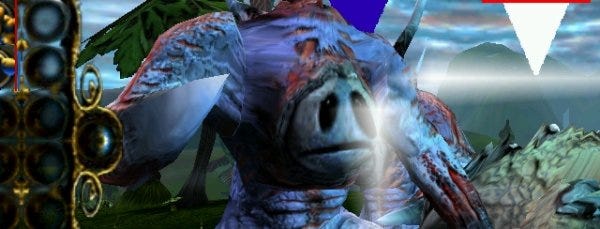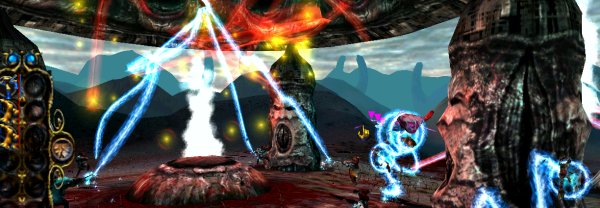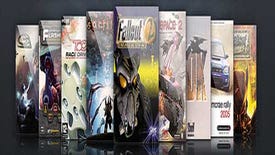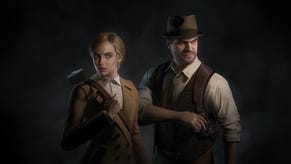The Making of: Sacrifice
[Another of my Making Of's from the vault. I was pleased that I got a chance to do this too - it's much easier to get a developer to talk about their previous game when it's one in a series which they've making a sequel to. It just ties into the whole PR cycle. Trying to get an interview just about something outside of that is a little trickier, and Eric Flannum was enormously gracious with his time. This is a slightly expanded version from PC Format's original, with some extra material. I replayed it last year actually, and lobbed my piece on Sacrifice's merits over on my blog a while back. If you like this, you may like that too.]
Sacrifice is one of the most distant landmarks in the PC gaming atlas, in an area marked “Here Be Dragons”. While spectacular, few people went there, and those who did came back reciting fantastical tales of strange vistas, genre-blending RTS/Action mechanics and a frankly wicked sense of humour. To game historians looking back from the far future, it’s going to prove as mystifying as Stonehenge is to archaeologists. How on earth did they build this?
Well, like everything, it started with an idea. “The inspiration was originally from our lead programmer, Martin Brownlow,” Eric Flannum, now at Arenanet tells, us, “He got the opportunity to start a team at Shiny, and basically able to make any game he wanted to. He’d also had the idea for the Sacrifice terrain engine”. The game he wanted was, essentially, a radical update of ancient Julian-Gollop spectrum classic Chaos, but in 3D.
Martin spent time gathering his team. Eric was approached via a mutual contact who he’d worked with at Blizzard. “I was looking for work at the time, and he called me. “Hey – we need a designer, and we’ve got this really cool engine and the basis of the game… but we could really use some help with refining”. So I came on board, and everything worked out from there”. Bar his need for money, what attracted him to that decision? “The team was really good,” Eric effuses, “Secondly, the striking look the game had. When you first see it, especially at the time, it was very… “Wow. That’s not like anything else I’d ever seen before”. And I’d always had a love for RTS and action games, and trying to combine the two was certainly a challenge and very intriguing”
With the game under away, when Eric arrived they had two priorities. “The single-player campaign and specing out the units and what they did,” he explains. “We had the idea that we wanted the campaign to be very freeform, so coming up with a structure was tricky, “he notes, “Working out how the story would work out since the player could take any God’s mission they wanted. Then looking at the unit balance, as players could mix and match different tiers, how do we make that work exactly.”
But the some of the hardest decisions were made around refining the game mechanics. “It had a lot of features,” Eric remembers, “You originally had more than one wizard and you could swap between them or inhabit any unit and take direct control, like in Dungeon Keeper 2. Also you had the ability to open three more gameplay windows centred on any unit, so you could have 4 points of view at any point.” Sounds awesome. Why lose it? “One of the things we found was that while they were really cool features, they tended to make the game more complicated and harder to play, muddied the interface and distracted from the main thing we were trying to get at – being the general on the battlefield thing,” he explains, “It’s always tough when you spend time implementing something to take it out, so they were pretty tough decisions. Are we going to gain something by losing this feature?”
He has no regrets about the decision, however. “I think they were big wins, as one of the biggest things which stood in the way of Sacrifice appealing more was that there were so many different and new things in it we were asking a lot from the player as far as what they had to learn and accept,” he explains, “From the visual style, from the lack of a disembodied camera… RTS players especially had a lot of new concepts to wrap themselves around” Of course, these “problems” were also some of the things which absolutely distinguished the game. “It was definitely one of the strengths of Sacrifice – its wacky visual look,” Eric considers the issue, “but at the same time… well, there’s something about “an archer” which communicates on a very basic level what that unit does. People don’t have to learn. But when you’ve got a little pyromaniac, there’s an extra step of learning. They don’t inherently know what he does.”
When asked if Sacrifice was a product of its time, whether something as unusual would be prevented by an accountants fear of blowing a mega-budgets on a curio, Eric finds another angle. “Even at the time, Sacrifice was a very small team at its core,” he notes, “We had two programmers who did the majority of the coding. For the longest time we only had one main designer. For artists, one animator. With team sizes being smaller, each individual has more of a chance to put their stamp on things as well, in addition to the budgetary concerns that making a really eclectic game is risky, the smaller team size lent itself to games being more quirky. With bigger teams it’s harder to remain fluid. It’s harder to react to a weird idea or something like that, as you have a much bigger ship to steer. With Sacrifice, if an artist had a crazy idea, it’s easier to just accommodate it”
Sacrifice was rife with those crazy ideas. For example, consider spells like “Bovine Intervention” sending an enormous cow speeding into the air to then crash directly on an unfortunate individual. “It was kind of a shiny trademark. James the God of Earth, and the way Stratos looks – god of air, so a balloon," Eric recalls, "We wanted to come at it from a very playful, fun and not taking ourselves too seriously angle… but at the same time try to tell a story that’s somewhat dark at the same time. About a guy who’s come from a place where his universe has just been destroyed, and he was responsible for it… then giving the player a little bit of choice whether they go down that road again or not”
In terms of its biggest problem, we return yet again to accessibility – and here the small team was actually a problem. “Sacrifice had more of a difficulty wall than a difficulty curve,” Eric says, “We didn’t realise this as developers, but there’s a certain point at which you understand the game. It sort of clicks for people. They’ll be playing it… and then it’s there. The QA guys and the team had been playing it, but it was harder than we realised as we’d gotten over the curve and become familiar with how to play it.”
But this is really overwhelmed by its strengths. “One of the things I’d really liked was the sound,” Eric argues, “I thought we did an exceptional job of it, and it’s a neglected part of a lot of games. It’s a fully third of the experience, I think and a lot of times it doesn’t get the attention it deserves. A lot of the things we did with the wizard calling out group numbers and orders and things gives the players a lot of feedback of what’s going on.”
What people often forget about Sacrifice is that well before Black & White, it implemented a gesture mouse-movement gesture system for ordering . “One of the strengths that system had was that for players who couldn’t do the gesture thing, you didn’t have to,” Eric notes, “You could treat it as a normal radial menu if you did it slowly. Go over and up and that’s the one that I want, while players that were really adept could do it. It would be nice to see someone take up the mantle of that and explore it a little more”
No matter what it’s successes, Sacrifice was a dead-end in the gaming history book. It never spawned a lineage. Where would they have taken Sacrifice next? And where would Eric like to see other people try to take its ideas. “We had some ideas we were talking about back when there was the possibility of an expansion – and there has been some games that have tried this, like Spellforce – but taking that campaign structure and going a step further,” Eric argues, “We were planning on being even more like an RPG, in that you were literally taking missions as quests from different characters and had a world to explore, and treating the ethereal realm as a level in itself. The merging genres too. I see more people approaching this from the action – like the Outfit, which has introduced a few strategy elements. It would be great to see some more strategy people trying to get that commander on the battlefield feeling”.














